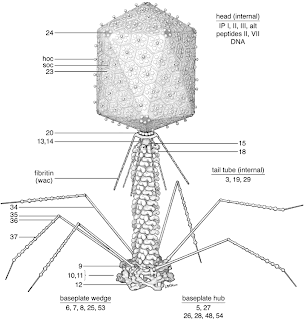
Bacerophage, named T4- virus attacks Escherichia coli. It completes its lifecycle inside the bacterial cells. Virus exhibits two types of life cycles –
1. Lytic life cycle –
In lytic life cycle, virus multiplies in host cell, which stages:
a) Adsorption – The bacteriophage attaches itself over the surface of host cell (bacteria) by means of tail fibers.
b) Penetration (Injection) – Tip of tail possesses an enzyme called lysozyme which dissolved cell wall of the host. The nucleic acid of bateriophage passes into host through tube. However, capsid and tail sheath remain outside, as they have no role in multiplication.
c) Formative phase – After entering into bacterium, the viral nucleic acid takes over all the cellular activity of host. Viral genome replicates itself and codes for new types of proteins which are viral lysozyme, internal proteins and coat proteins.
d) Mutation – The coat proteins wrap itself over the viral genomes to produces a new virus. The period between the entry of phage genome inside bacterium upto formation of first new virus is called eclipse period. It is about 13 min in T4 bacteriophage.
e) Lysis – Soon after maturation, host cell wall ruptures, probably by the presence of some free lysozyme. The newly formed bacteriophages are released. They repeat the cycle again when they come in contact with another bacteria.
2. Lysogenic life cycle – In this cycle, the host does not undergo death and virus does not multiply in the hot cell. In case of some bacterio-phage, its genome does not take over the control of cellular machinery of host. Viral genome is integrated with host DNA. Stage is called prophage. Viral genime replicates along with host DNA.
When it breaks from host DNA, it may carry some host genes along with, which may be transferred to other cells on being infected. Such a mode of division of the prophage is called lysogey. The host bacterium is termed as lysogenic bacterium.
Retro-virus and Reverse transcription
Some DNA viruses (retroviruses) have a gene which codes for the enzyme reverse transcriptase. It helps in the synthesis of double stranded DNA from its original single RNA strand. This phenomenon is called reverse transcription.
RNA viruses capable of reverse transcription are called retrovirus. This phenomenon was described by D. Baltimore in 1970. Tumor causing virus and AIDS causing HIV are the example of retrovirus exhibiting reverse transcription.
About 20 viral gene have been identified which are responsible for triggering cancer cells which are known as oncogenes. Upon activation of oncogenes, cells divide abnormally and uncontrolled causing diseases cancer. However, the origin of cancer is a complex phenomenon.

0 comments:
Post a Comment